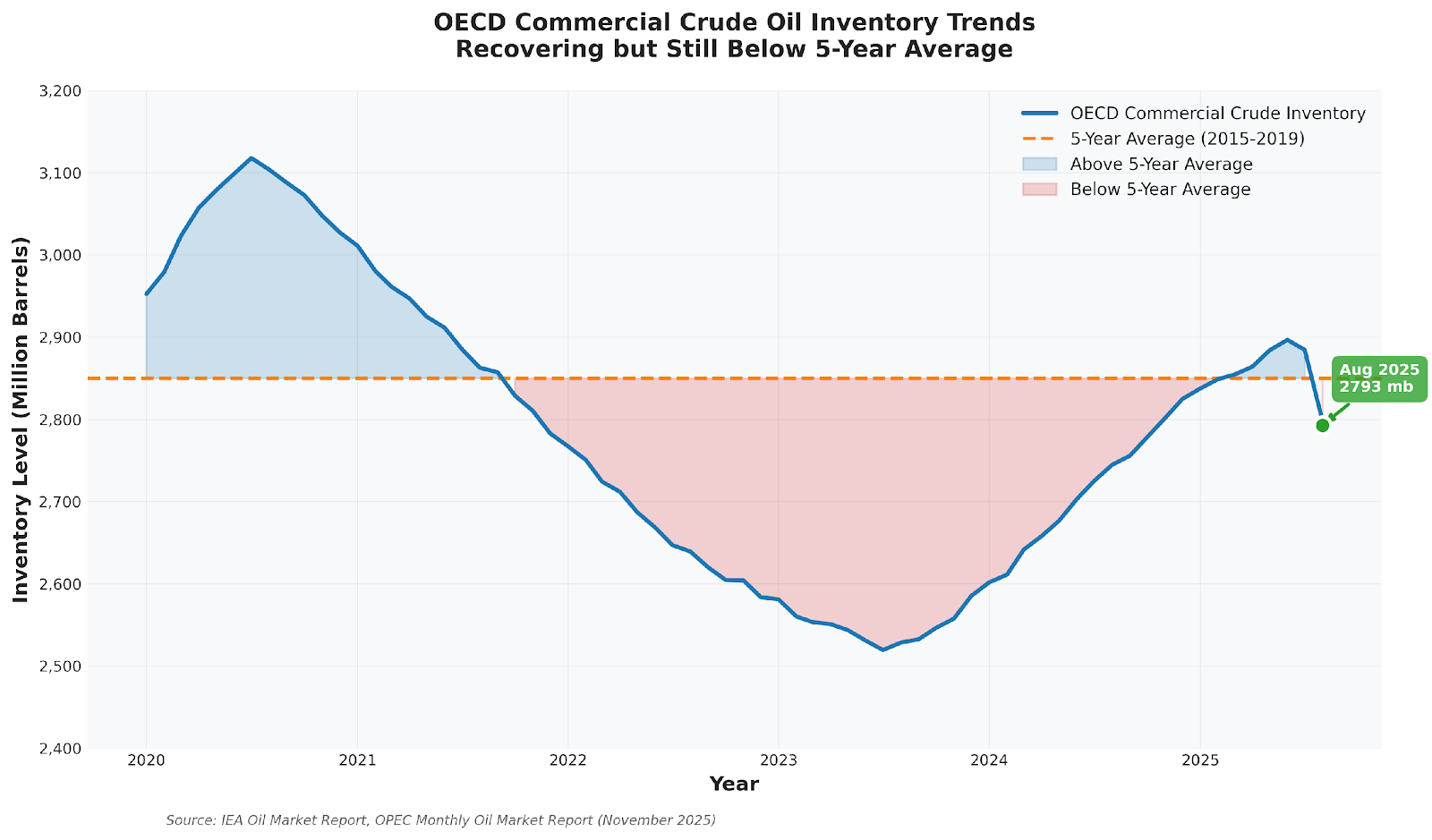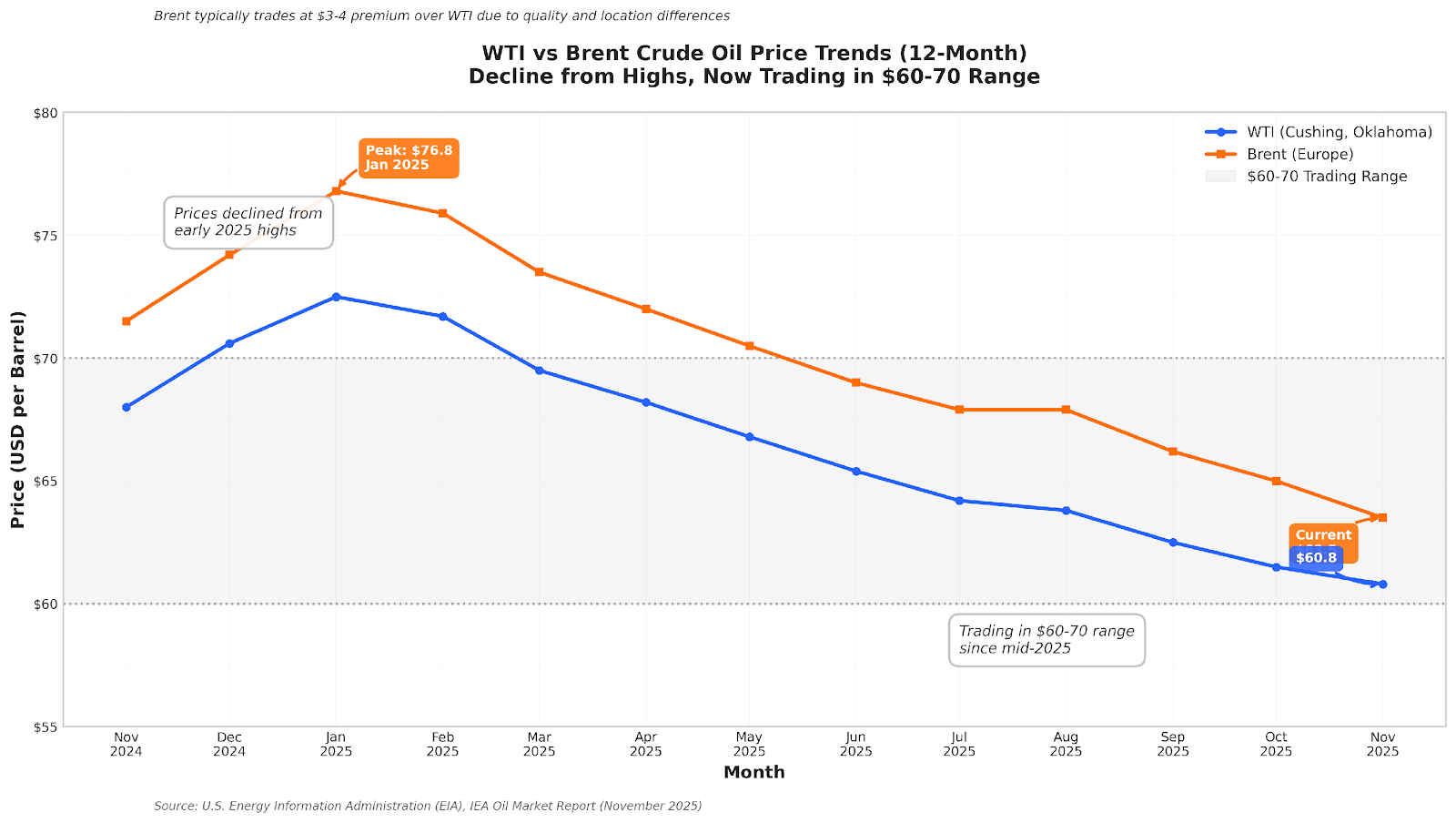市场资讯及洞察
.jpg)
摘要
IEA 最新月报显示,全球石油需求增速放缓但仍具韧性。尽管库存持续回升,但 OECD 库存整体仍低于五年均值,市场对供应中断高度敏感。OPEC、IEA、EIA 均上调非 OPEC 供应,未来可能出现“松中带紧”的供需结构。原油价格在供应宽松预期与地缘扰动之间反复震荡,波动率下降但敏感度上升。油市表现也可能通过风险偏好外溢至能源板块、商品货币及相关市场。
一、全球原油供需前景:IEA 月报核心要点
国际能源署(IEA)最新原油月报显示,全球石油需求虽较去年降温,但整体依旧保持韧性 [1]。先进经济体消费表现好于预期,有效抵消部分新兴市场的疲弱需求。IEA 预计 2025–2026 年全球石油需求将保持温和增长。然而在供应方面,如果 OPEC+ 维持当前产量政策且需求不出现明显下滑,全球石油市场未来数个季度可能重新进入“边际紧平衡”状态。IEA 同时指出,高油价、全球经济放缓、电动车渗透等因素正在逐步压制需求增速,使油市呈现出“短期紧平衡、长期温和宽松”的结构。
二、多机构观点对比:OPEC、EIA 与 OECD 数据
三大机构对于未来市场平衡的看法存在显著差异,这主要源于对非 OPEC+ 供应增长和需求韧性的不同假设。总体来看,市场普遍认同未来供应将更加充裕,但对于过剩的规模和时间点存在分歧。

图 3:三大机构对 2025-2026 年需求与供应增长的预测对比,显示供应增长普遍超过需求增长,预示市场将进入供应过剩周期。
OPEC 的观点相对乐观。OPEC 预计 2025 年全球石油需求将增长约 130 万桶/日,2026 年略高至 140 万桶/日 [2]。与此同时,OPEC 在最新报告中连续上调非 OPEC 供给预期,并首次将 2026 年市场从“短缺”调整为“小幅过剩”,反映其判断未来供应增长可能快于需求。
EIA 的判断更偏向供应充裕。EIA 上调了美国页岩油产量预测,指出 2025 年美国原油产量将创历史新高。同时,全球供应预期被上调至日均 1.06 亿桶,高于全球消费的 1.041 亿桶,意味着未来库存可能持续累积 [3]。EIA 预期 2025–2026 年库存增加将对油价形成中期压力。
OECD 库存虽然持续回升,但仍低于五年均值。IEA 数据显示,今年全球观测库存前八个月净增约 2 亿桶,但 OECD 商业库存仍比五年均值低约 6700 万桶。整体来看,库存虽然恢复,但仍处历史偏低区间,使油市对供应中断的敏感度依旧很高。

图 1:OECD 商业原油库存近 5 年对比最新水平,显示库存虽有回升但仍低于五年均值。
三、原油价格走势:WTI 与 Brent 如何消化预期
2023 年下半年,布伦特因供应紧张和地缘冲突预期一度突破每桶 90 美元。然而进入 2024–2025 年,随着供应回升和库存恢复,油价整体震荡下移。近期价格承压主要来自供应过剩预期强化以及美国库存意外上升。

图 2:WTI 与 Brent 价格从 2025 年初的高位回落,近期在 60–70 美元区间震荡。
尽管地缘事件偶尔推升价格,但反弹难以持续,因为供应宽松的结构性预期迅速重新主导市场。WTI 与 Brent 的期限结构一度出现小幅 Contango,显示短期供应充裕压制近端价格,而远月因长期需求预期而保持相对坚挺。整体来看,油市呈现低波动、弱趋势但对消息高度敏感的特征。
四、驱动油市的关键变量:地缘政治与供应端不确定性
运输通道风险仍是油市最大的潜在冲击点之一。全球三分之一海运原油经过霍尔木兹海峡,一旦受阻便可能引发油价剧烈波动。衍生品定价显示断供概率虽低,但属于典型的“低概率、高冲击”事件。
OPEC+ 的政策滞后性也带来结构性波动。减产会压低库存、推高价格,但高油价又刺激非 OPEC 增产,使市场重新宽松。美国页岩油增速放缓进一步加剧供应端的不确定性,削弱其作为“摇摆产能”的角色。此外,俄罗斯、伊朗等国因制裁和冲突导致出口波动,更加剧油市敏感性。
五、油市变化的外溢影响
能源板块通常与油价同方向变动,但反应速度较油价更平缓。油价对风险偏好的溢出效应也容易影响澳元等商品货币。大宗商品价格上行往往提升商品出口国的贸易条件与风险情绪,而价格下跌则可能压制相关货币表现。
六、原油市场风险提示
- 数据发布风险: EIA 每周库存、IEA 与 OPEC 月报可能导致短线波动。
- 地缘政治风险: 产油区冲突、海运通道中断、制裁变化均可能影响供需平衡。
- 宏观风险: 利率政策、美元走势及全球经济增速变化都可能改变需求前景。
结语
IEA 最新展望显示,全球油市进入“边际紧平衡”阶段:库存修复但仍偏低,供应端不确定性大于需求端。在这种结构性环境下,油市会对政策、地缘事件与供给变化表现出高度敏感。理解供需框架、关注库存趋势与识别关键风险,将是未来判断油市走向的关键。
参考资料
[1] IEA (International Energy Agency). (2025, October). Oil Market Report - October 2025. https://www.iea.org/reports/oil-market-report-october-2025
[2] OPEC (Organization of the Petroleum Exporting Countries). (2025, November). Monthly Oil Market Report. https://publications.opec.org/momr
[3] EIA (U.S. Energy Information Administration). (2025, November). Short-Term Energy Outlook. https://www.eia.gov/outlooks/steo/


Market response to any specific economic data release is far from standard even if actual numbers differ greatly from consensus expectations. Rather the market response is based on context of the current economic situation. This week’s non-farm payrolls, being one of the major data points in the month, is a great case in point.
There are many factors and of course the key one for you as an individual trader is your chosen vehicle you are trading (and of course direction i.e. long or short for open positions). The context of today’s impending non-farm payrolls from a market perspective is interest rate expectations going forward. This week the Fed gave the market the expected.25% cut that was already priced into currency, bond and equity market pricing.
The market response however, as this was already priced in, was as a result of the accompanying statement which was not as dovish as perhaps anticipated and a reduction in expectations of a further imminent cut. From an equity market point of view the result, despite the interest rate cut, was to sell off, whereas from the USD perspective this lessening expectation of further rate cuts was bullish. Perhaps this could be viewed as contrary to what the textbooks would suggest is a standard response.
So, onto today's non-farm payrolls (NFP) figure… Logic would suggest that a strong number is good news for the economy, and so should be positive for equities and perhaps bearish for USD. However, as this may be a critical number in the Feds decision making re. interest rate decisions, a strong NFP is likely to have the opposite effect. A weaker number is likely to be perceived as potentially contributory to thinking that another rate cut may be prudent sooner and so despite on the surface being “bad news”, it would not be surprising to see equities stronger and USD weaker.
It remains to be seen of course what the number is and the actual response but is perhaps a lesson in seeing new market information within the potential context of the current economic circumstances and of course incorporate this in your risk assessment and trading decision making. Mike Smith Educator Go Markets [email protected] Disclaimer The articles are from GO Markets analysts based on their independent analysis. Views expressed are of the their own and of a ‘general’ nature.
Advice (if any) are not based on the readers personal objectives, financial situation or needs. Readers should therefore consider how appropriate the advice (if any) is to their objectives, financial situation and needs, before acting on the advice.


At the recent GO Markets Daryl Guppy seminar, we had a presentation from Daryl that covered both an insightful economic outlook as well as some of his technical trading approaches. During the seminar, a question was asked about how to match the two. i.e. if you have an economic idea how can you integrate this into your trading style. We have put together one potential approach that could be used for your consideration.
Arguably, the same rigour of process should be applied to this as with any trading strategy, and this video presentation aims to outline such a potential process. Traditionally, many Forex and CFD traders, enter short term, often intraday positions. With a longer term economic view, generally you are placing a longer term trade, based on that view with the idea that it could move in your desired direction.
As well as share holdings, this trading approach is very possible with Forex, index and commodity CFDs and of course, share CFDs with the potential advantage of being able to trade "short" easily compared to when trading shares. The video is a recording of this weeks Inner Circle session (we have edited out the market watch section of the recording to focus on the educational component). https://vimeo.com/377703349


Please find the recording of the Latest Inner Circle session, the first in our NEW interviews with successful traders series. Nigel Hawkes is the epitome of a lifetime trader, now at 71 he trades for a living. Hear his fascinating trading journey, the foundation principle of "Six ways the market moves" and his 3 golden rules he abides by in his trading on a daily basis.
You can make the video full screen by clicking on the icon in the bottom right hand corner. Couple of quick notes: a. When Nigel refers to the ES aas an instrument this is the S&P500 E-mini contract (so not dissimilar to the SP500 CFD). b.
Nigel chooses to use minutes as a personal choice not available so 240 minutes = 4 hours (not available on MT4/5). https://vimeo.com/385016331 Any comments or questions to [email protected] Don't forget the latest "Next steps" course starts next week, click HERE for more information and get on board. If you are not yet a member of "Inner Circle" don't miss out and join us (click HERE to find out more) Mike Smith Educator and course facilitator GO Markets


Another fantastic webinar session yet again, with this week's session of the Interviews with Successful Traders series featuring Mark Austin of Magnetic Trading, whose main speciality is Index trading. What Mark shared not only had relevance to Index trading, but also across all trading vehicles. We are delighted to share the video from the session which you can watch here.
There is also an opportunity to see Mark and partner Cameron Malik in action, implementing some of the trading strategies that were referenced in the session as part of a special two-week free trial of their LIVE trading room, exclusive only to GO Markets clients. Gain access here. https://vimeo.com/391110084 If you have any questions about this session, please feel free to drop a line through to me at [email protected] Trade Safe, Mike Smith Educator and course facilitator Go Markets Disclaimer The article from GO Markets analysts is based on their independent analysis. Views expressed are of their own and of a ‘general’ nature.
Advice (if any) are not based on the reader’s personal objectives, financial situation or needs. Readers should, therefore, consider how appropriate the advice (if any) is to their objectives, financial situation and needs, before acting on the advice.


Your trading plan is arguably THE most important system to have in place and having a complete and evidence-based plan may for many be a key goal to aim for in your 2020 trading journey. It should serve you in guiding your every trading action, for every vehicle, in entry, intra-trade management and exit. We want to help you achieve this aim.
We have discussed on many occasions how making each statement sufficiently specific and unambiguous will not only enable you to develop the consistently that most experienced traders suggest is crucial for long-term positive outcomes but will facilitate measurement so you can amend your plan to better fit your individual trading style. This week GO Markets Inner Circle session tackled this topic head on. Find below the video from last nights Inner Circle session "How to make your trading plan potentially serve you better in 2020?" You can watch with 'full screen' by clicking on the icon in the bottom left corner. https://vimeo.com/380241718 If you want to join us for future "Inner Circle" sessions please feel free to CLICK HERE to find out more and register to join this growing trading education community.
Mike Smith Educator GO Markets


We frequently refer both in the articles we publish and the weekly “Inner Circle” sessions we present, to the benefits of a trading journal. However, the reality is that many traders make the choice not to measure trading despite the logical benefits of doing so. Whether you do or don’t currently, the bottom-line decision you are making is not only whether you do or don’t but how that positions yourself with your trading development.
We would suggest that this overall choice can be broken down into the following three sub-choices. You can make the decisions that are right for you subsequently. Sub-choice 1 – Measuring your system You are either making the choice to: Have certainty on not only whether your trading plan as a whole can create positive outcomes but have evidence to know which component parts of your plan are e.g. indicators you use for entry and exit, comparing strategies you trade, timeframes that work best for you, (and which are not) contributing to such outcomes.
Additionally, it allows you to compare what would happen if you change some of the perimeters on your potential results. OR You have no evidence as to whether your system as a whole and its components parts are working well to serve you in getting the results you desire. Nor do you can test and gather evidence as to what the impact of nay changes you may make to that system, Ask yourself… If I am serious about trading results which choice should I make?
Sub-choice 2 – Measuring you as a trader You are either making the choice to: Know the degree to which you are following your plan or otherwise so you can ultimately make a judgement on: a. Whether your system is working for you (all the points in sub-choice 1 above CANNOT be made unless you are following your plan religiously). b. What you need to work on in terms of tightening your behaviour e.g. on exits or entry c.
Whether there are certain market conditions which you find difficult or are ill-prepared for (so you can fill any knowledge gaps or avoid in the future). OR You can continue to trade as you do, avoiding any self-assessment and growth, and the refinement of your behaviour that may contribute to more positive trading outcomes. Ask yourself… If I am serious about trading results which choice should I make?
Sub-choice 3 – Improving your trading (closing the circle) (let’s assume you are keeping a journal for this one) You are either making the choice to: Measure with purpose that has clear follow through into further development and refinement of your trading plan and subsequently your actions. This facilitates the development of you as a trader based on your individual character and trading style. In practical terms, you ‘close the circle’ with a defined review and develop an action plan based on your review to test and change parts of your plan.
This is evidence-based trading! OR You can measure for measurements sake to on the surface appear to be “doing a right thing” but in reality, failing to unleash the real power of journaling, that is to make an on-going and continuous positive difference to your trading outcomes. Ask yourself… If I am serious about trading results which choice should I make?
In summary, if you have made the choice to read this article to its end you are left with one ultimate choice…to journal or not to journal including the three sub-choices that dependent on which you are making can impact on your trading. So, for one last time, Ask yourself… If I am serious about trading results what should my actions be with what I have read in this article? Our next steps and Share CFD education programme both have indicative trading journal templates to help get you started, and we would be delighted if you could join us.
Mike Smith Educator GO Markets Disclaimer The articles are from GO Markets analysts based on their independent analysis. Views expressed are of their own and of a ‘general’ nature. Advice (if any) are not based on the reader’s personal objectives, financial situation or needs.
Readers should, therefore, consider how appropriate the advice (if any) is to their objectives, financial situation and needs, before acting on the advice. Find additional Forex trading education resources here. Next: 5-point checklist for using chart patterns within your tradin

